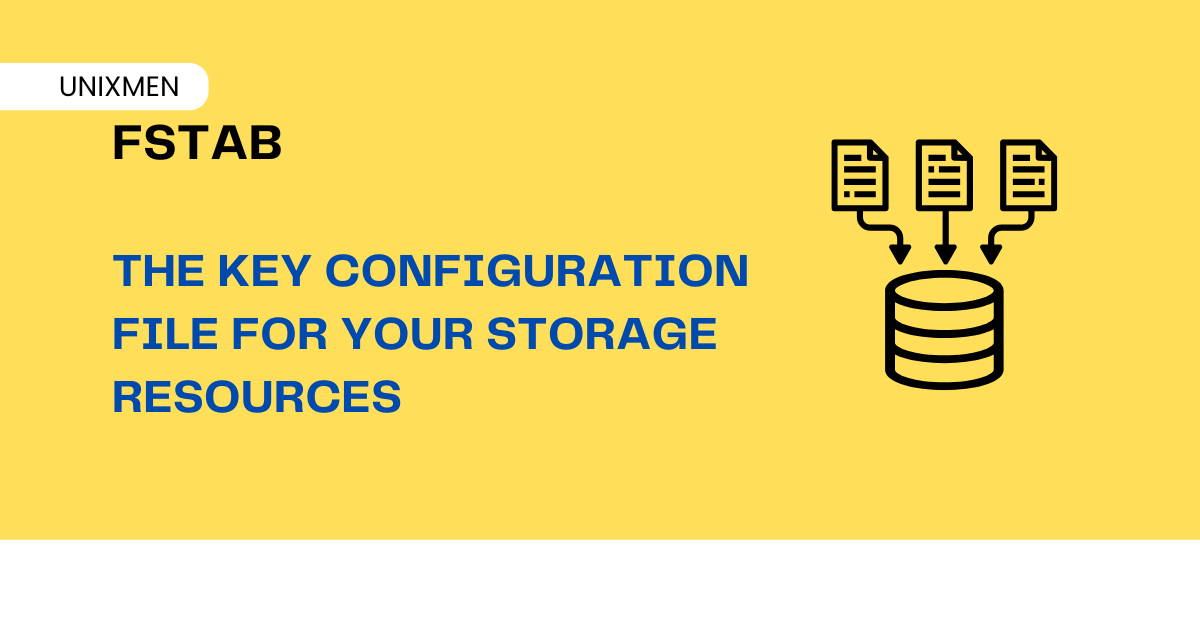fstab: Storage Resource Configuration File
Fri, 25 Apr 2025 05:26:26 +0000

Today at Unixmen, we are about to explain a key configuration file that defines how disk partitions, devices, and remote filesystems are mounted and integrated into the system’s directory structure. The file we are talking about is the “/etc/fstab”. By automating the mounting process at boot time, fstab ensures consistent and reliable access to various storage resources.
In this article, we will explain the structure, common mount options, best practices, and the common pitfalls learners are prone to face. Let’s get started!
Structure of the “/etc/fstab” File
Each line in the “fstab” file represents a filesystem and contains six fields, each separated by spaces or tabs. Here are the components:
- Filesystem: Specifies the device or remote filesystem to be mounted, identified by device name (for example: “/dev/sda1”) or UUID.
- Mounting point: The directory where the filesystem will be mounted, such as “/”, “/home”, or “/mnt/data”.
- Filesystem type: Indicates the type of filesystem, like “ext4”, “vfat”, or “nfs”.
- Options: Comma-separated list of mount options that control the behaviour of the filesystem like “defaults”, “noatime”, “ro”.
- Dump: A binary value (0 or 1) used by the “dump” utility to decide if the filesystem needs to be backed up.
- Pass: An integer (0, 1, or 2) that determines the order in which “fsck” checks the filesystem during boot.
Some of the Common Mount Options
Let us look at some of the common mount options:
- defaults: This option applies the default settings: “rw”, “suid”, “dev”, “exec”, “auto”, “nouser”, and “async”.
- noauto: Prevents the filesystem from being mounted automatically at boot.
- user: Allows any user to mount the filesystem.
- nouser: Restricts mounting to the superuser.
- ro: Mounts the filesystem as read-only.
- rw: Mounts the filesystem as read-write.
- sync: Ensures that input and output operations are done synchronously.
- noexec: Prevents execution of binaries on the mounted filesystem.
As usual, let us understand the concept of “fstab” with an example. Here is a sample entry:
UUID=123e4567-e89b-12d3-a456-426614174000 /mnt/data ext4 defaults 0 2
Let us break down this example a little.
- UUID=123e4567-e89b-12d3-a456-426614174000: Specifies the unique identifier of the filesystem.
- /mnt/data: Designates the mount point.
- ext4: Indicates the filesystem type.
- defaults: Applies default mount options.
- 0: Excludes the filesystem from “dump” backups.
- 2: Sets the “fsck” order. Non-root filesystems are typically assigned “2”.
Best Practices
While the fstab file is a pretty straightforward component, here are some best practices to help you work more efficiently.
- Always use UUIDs or labels: Employing UUIDs or filesystem labels instead of device names (like “/dev/unixmen”) enhances reliability, especially when device names change due to hardware modifications.
- Create backups before editing: Always create a backup of the “fstab” file before making changes to prevent system boot issues.
- Verify entries: After editing “fstab”, test the configuration with “mount -a” to ensure all filesystems mount correctly without errors.
Common Pitfalls You May Face
Misconfigurations in this file can lead to various issues, affecting system stability and accessibility. Common problems you could face include:
Incorrect device identification: Using device names like “/dev/sda1” can be problematic, especially when hardware changes cause device reordering. This can result in the system attempting to mount the wrong partition. Using an incorrect Universally Unique Identifier (UUID) can prevent the system from locating and mounting the intended filesystem, leading to boot failures.
Misconfigured mount options: Specifying unsupported or invalid mount options can cause mounting failures. For example, using “errors=remount-rw” instead of the correct “errors=remount-ro” will cause system boot issues.
File system type mismatch: Specifying an incorrect file system type can prevent proper mounting. For example, specifying an “ext4” partition as “xfs” in “fstab” will result in mounting errors.
Wrapping Up
You could have noticed that the basics of fstab does not feel that complex, but we included a thorough section for the best practices and challenges. This is because identifying the exact cause of fstab error is little difficult for the untrained eye. The error messages can be vague and non-specific. Determining the proper log fail for troubleshooting is another pain. We recommend including the “nofail” option, so that the system boots even if the device is unavailable. Now you are ready to work with the fstab file!
Related Articles
- How to Rename Files in UNIX / Linux
- Untar tar.gz file: The Only How-to Guide You Will Need
- Fsck: How to Check and Repair a Filesystem
The post fstab: Storage Resource Configuration File appeared first on Unixmen.
Recommended Comments